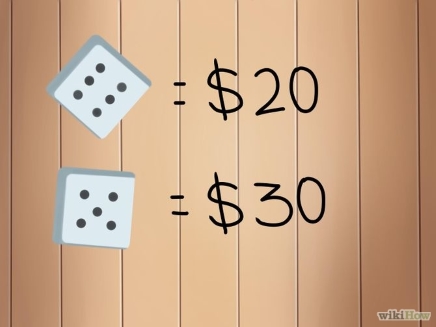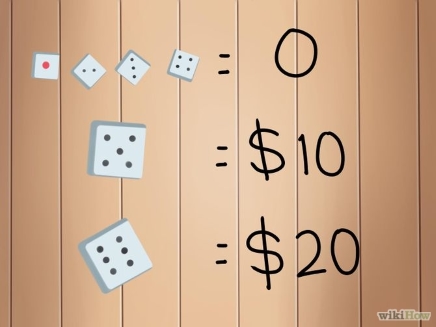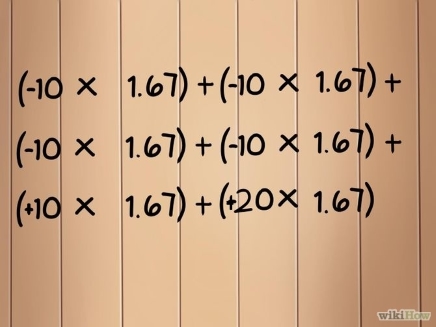Math Portal
Introductory Statistics
Section 2.8 - Expected Values
Expected value is a concept employed in statistics, and is a useful concept for deciding how beneficial or harmful an action will be. To calculate an expected value, you need to gain an understanding of each outcome in a situation and its probability, or chance of each outcome occurring. The steps below will guide you through a couple example problems to teach you the concept of an expected value.
Step 1
Familiarize yourself with the problem. Before thinking about all the possible outcomes and probabilities involved, make sure to understand the problem. For example, consider a die-rolling game that costs $10 per play. A 6-sided die is rolled once, and your cash winnings depend on the number rolled. Rolling a 6 wins you $30; rolling a 5 wins you $20; rolling any other number results in no payout.

Step 2
List all the possible results. It helps to make a list of all the possible results in the given situation. In the example above, there are 6 possible results. They are: (1) roll a 1 and lose $10, (2) roll a 2 and lose $10, (3) roll a 3 and lose $10, (4) roll a 4 and lose $10, (5) roll a 5 and win $10, and (6) roll a 6 and win $20.
Note that each outcome is $10 lower than described above, because you have to pay $10 to play the game no matter what result you roll.

Step 3
Determine the probability of each outcome. In this case, the probability of each of the 6 outcomes is the same. When rolling a 6-sided die, the chance of a particular number being rolled is 1 in 6. To make it easier to write and calculate, we'll turn this fraction (1/6) into a decimal by plugging it into a calculator: 0.167. Write this probability next to each outcomes, especially if you are solving a problem with a different probability for each outcome.
If you put 1/6 into a calculator, you might actually get something like 0.166667. We're rounding the decimal to 0.167 to make things easier to calculate. It's close to the actual number, so we'll still get a pretty accurate result.
If you want a very accurate result and you have a calculator with a parenthesis button, write (1/6) instead of 0.167 when you calculate the formulas below.
Step 4
Write down the value of each result. Multiply the $ amount of one result by the chance of that result happening by the to find out how many dollars that result contributes to the expected value. For instance, the result of rolling a 1 is -$10 and the chance of rolling a 1 is 0.167. The value of rolling a 1 is therefore (-10) * (0.167).

Step 5
Add the value of each result together to get the expected value of the event. Continuing with the example above, the expected value of the dice game is:
(-10 * .167) + (-10 * .167) + (-10 * .167) + (-10 * .167) + (10 * .167) + (20 * .167), or - $1.67.
Therefore, when playing the dice game, you should expect to lose $1.67 per game played.
Step 6
Understand the implications of the expected value calculation. In the example above, it was determined that the expected winnings of the game were -$1.67 per roll. This is an impossible outcome for one game; you can only either lose $10, win $10, or win $20. However, the expected value is useful as a long-term average figure. If you play this dice game over and over, you will lose somewhere near $1.67 per game on average. Another way to think of expected value is assigning the game a particular cost (or benefit) of playing; you should only decide to play the game if the fun of playing is worth paying $1.67 each time.
The more times the situation is repeated, the more accurately the expected value will mirror the actual average outcome. For example, you might play the game five times in a row and lose every time, resulting in an average loss of $10. However, if you were to play the game 1,000 times or more, your average result would almost always be close to the expected value of -$1.67 per game. This principle is called the "law of large numbers."
Expected value is a concept employed in statistics, and is a useful concept for deciding how beneficial or harmful an action will be. To calculate an expected value, you need to gain an understanding of each outcome in a situation and its probability, or chance of each outcome occurring. The steps below will guide you through a couple example problems to teach you the concept of an expected value.
Step 1
Familiarize yourself with the problem. Before thinking about all the possible outcomes and probabilities involved, make sure to understand the problem. For example, consider a die-rolling game that costs $10 per play. A 6-sided die is rolled once, and your cash winnings depend on the number rolled. Rolling a 6 wins you $30; rolling a 5 wins you $20; rolling any other number results in no payout.

Step 2
List all the possible results. It helps to make a list of all the possible results in the given situation. In the example above, there are 6 possible results. They are: (1) roll a 1 and lose $10, (2) roll a 2 and lose $10, (3) roll a 3 and lose $10, (4) roll a 4 and lose $10, (5) roll a 5 and win $10, and (6) roll a 6 and win $20.
Note that each outcome is $10 lower than described above, because you have to pay $10 to play the game no matter what result you roll.

Step 3
Determine the probability of each outcome. In this case, the probability of each of the 6 outcomes is the same. When rolling a 6-sided die, the chance of a particular number being rolled is 1 in 6. To make it easier to write and calculate, we'll turn this fraction (1/6) into a decimal by plugging it into a calculator: 0.167. Write this probability next to each outcomes, especially if you are solving a problem with a different probability for each outcome.
If you put 1/6 into a calculator, you might actually get something like 0.166667. We're rounding the decimal to 0.167 to make things easier to calculate. It's close to the actual number, so we'll still get a pretty accurate result.
If you want a very accurate result and you have a calculator with a parenthesis button, write (1/6) instead of 0.167 when you calculate the formulas below.
Step 4
Write down the value of each result. Multiply the $ amount of one result by the chance of that result happening by the to find out how many dollars that result contributes to the expected value. For instance, the result of rolling a 1 is -$10 and the chance of rolling a 1 is 0.167. The value of rolling a 1 is therefore (-10) * (0.167).

Step 5
Add the value of each result together to get the expected value of the event. Continuing with the example above, the expected value of the dice game is:
(-10 * .167) + (-10 * .167) + (-10 * .167) + (-10 * .167) + (10 * .167) + (20 * .167), or - $1.67.
Therefore, when playing the dice game, you should expect to lose $1.67 per game played.
Step 6
Understand the implications of the expected value calculation. In the example above, it was determined that the expected winnings of the game were -$1.67 per roll. This is an impossible outcome for one game; you can only either lose $10, win $10, or win $20. However, the expected value is useful as a long-term average figure. If you play this dice game over and over, you will lose somewhere near $1.67 per game on average. Another way to think of expected value is assigning the game a particular cost (or benefit) of playing; you should only decide to play the game if the fun of playing is worth paying $1.67 each time.
The more times the situation is repeated, the more accurately the expected value will mirror the actual average outcome. For example, you might play the game five times in a row and lose every time, resulting in an average loss of $10. However, if you were to play the game 1,000 times or more, your average result would almost always be close to the expected value of -$1.67 per game. This principle is called the "law of large numbers."